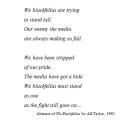AustLit
Latest Issues
Publication Details of Only Known VersionEarliest 2 Known Versions of
Works about this Work
-
BlackWords : Writers on Identity
2014
single work
criticism
— Appears in: JASAL , vol. 14 no. 3 2014; The BlackWords Essays 2015; (p. 2) The BlackWords Essays 2019;'In the 1960s Oodgeroo Noonuccal (then Kath Walker) hit the literary limelight as Australia’s first published ‘Aboriginal poet’ and since then Aboriginal writers have used their work as a form of self-definition and to defend our rights to our identity. Many authors are inspired by the need to redress historical government definitions of Aboriginality, to reclaim pride in First Nation status, to explain the diversity of Aboriginal experience, and to demonstrate the realities and complexities of ‘being Aboriginal’ in the 21st century.'
Source: Author's introduction.
-
BlackWords : Writers on Identity
2014
single work
criticism
— Appears in: JASAL , vol. 14 no. 3 2014; The BlackWords Essays 2015; (p. 2) The BlackWords Essays 2019;'In the 1960s Oodgeroo Noonuccal (then Kath Walker) hit the literary limelight as Australia’s first published ‘Aboriginal poet’ and since then Aboriginal writers have used their work as a form of self-definition and to defend our rights to our identity. Many authors are inspired by the need to redress historical government definitions of Aboriginality, to reclaim pride in First Nation status, to explain the diversity of Aboriginal experience, and to demonstrate the realities and complexities of ‘being Aboriginal’ in the 21st century.'
Source: Author's introduction.




